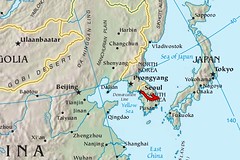Gyeongsangbuk-do Province
Just outside Yeongju, near Misun's grandparents' house is Seonbichon, a traditional folk village, which has been recreated as a living museum. There are a variety of houses, rich and poor. In each house there is a central courtyard which is open to the sky. When you walk through the main door into the courtyard a raised semi-open area faces you—this was used as a living area in the summer. The bedrooms and winter living rooms have small doors opening onto the courtyard. Everything is built on large wooden stilts so that the floors can be heated from underneath by fires.
Seonbichon also doubles as a hotel for tourists and Koreans who fancy seeing what it would have been like to live in an old Korean village, and so this was where we would be staying the first night of the Year of the Rat. Misun had negotiated one of the best rooms in the whole village for us at a bargain price. It was off-season and we nearly had the place to ourselves, but even so, getting it for a third of the normal price was an incredible achievement. So, we would be living as the lord and lady of the manor for a night. We arrived at sunset so we didn't have much time to look around the village. Being February it was bitterly cold anyway. After climbing in through the tiny paper doorway to our room we found ourselves in a small but warm cocoon with a huge Korean-style mattress on the floor and several layers of brand new, soft silk sheets over it. The furniture was made of dark wood with inlaid mother-of-pearl and heavy brass fittings, and a painted screen stood at the end of the room.
In the morning a knock on the door meant that breakfast had arrived. We had been given the choice of a Western breakfast, but we had chosen the Full Korean instead, to our hosts' delight. It was a banquet of kimchi (did you doubt it?), rice, soup, seaweed and various pickled vegetables.
After breakfast we braved the freezing morning to go for a shower in the bathroom, which was in a small shed outside the courtyard. Putting in ensuite bathrooms would be impossible in a place like this.
Misun and her mum arrived at the village and after a look round Sosu Seowon, the Silla (pronounced Shilla) school next door to Seonbichon, we hitched another ride with Misun's mum to Yeongju railway station to catch a train to Gyeongju in the south-eastern corner of Korea. On the train we met up with Tae Eun, Misun's university friend and a history major. She had left Seoul earlier in the day.
Gyeongju was the capital of the Silla empire, one of the ancient Three Kingdoms. It's one of the top tourist destinations in Korea, famous for four main sights:
- Cheomseongdae: an ancient astronomical observatory
- Cheonmachong: an excavated burial tomb
- Seokguram: a giant stone Buddha statue in a cavern in the hillside
- Bulguksa: a Buddhist temple with two famous stone pagodas
The historic sites are well worth a visit; also worth dropping into is Shilla Millennium Park: a brand new historical theme park. We were walking through the sculpture park towards the arena to watch a display of ancient military techniques when we noticed that three westerners and a Korean were listening to Misun and Tae Eun telling us all about Silla history. They turned out to be Norwegian oil prospectors on a business trip who had been caught with nothing to do during the new year holiday. Their Korean minder spoke only a little English (and no Norwegian) and in any case he wasn't from the area, so they were all feeling a bit lost.
Misun, who loves to talk to everyone, was happy to act as an impromptu tour guide to three Norwegians, as well as two Brits. They were so grateful they invited us to join them for lunch as a thank you. It seems there is such a thing as a free lunch!
For our third night away from Seoul we took a local bus to the coast and all stayed in a pension on the seafront. It is a Korean tradition to go to the East Sea (which the rest of the world usually calls the Sea of Japan) at Lunar New Year to watch the first sunrise of the year. Misun, ultra-reliable as ever, made sure that we were awake just before dawn, then told us that it was cloudy and we wouldn't be able to see the sunrise!
We went back to Gyeongju after a breakfast of instant noodles for more sightseeing, and after a long day ended up in a slightly strange coffee shop waiting for our train back to the capital. Finally, Tae Eun and the two of us left Misun in Gyeongju as she has a job interview there. Five hours later we arrived into Seoul Station at 03:00 on Sunday morning. Tae Eun had volunteered her dad as a taxi driver, so we had yet another free ride to get home.
As we directed Tae Eun's father to our apartment, we drove around the ancient southern gate to Seoul, Namdaemun. Seeing the gate lit up as always, and surrounded by the skyscrapers of Seoul's financial district, was nice—it felt like coming home. We didn't know it at the time but we will probably never see our favourite Korean landmark again...
Days 441-442
Yeongju to Seoul
This map shows the route we took in this post. Click it to see larger maps of our whole route at flickr.
Maps are taken from the CIA World Factbook.

![[IMG_3249]](http://farm3.static.flickr.com/2195/2256540157_caa2a1ff10_m.jpg)
![[IMG_3254]](http://farm3.static.flickr.com/2383/2257356312_f167802eaf_m.jpg)
![[IMG_3304]](http://farm3.static.flickr.com/2017/2257503156_e69ceba541_m.jpg)




Post a Comment